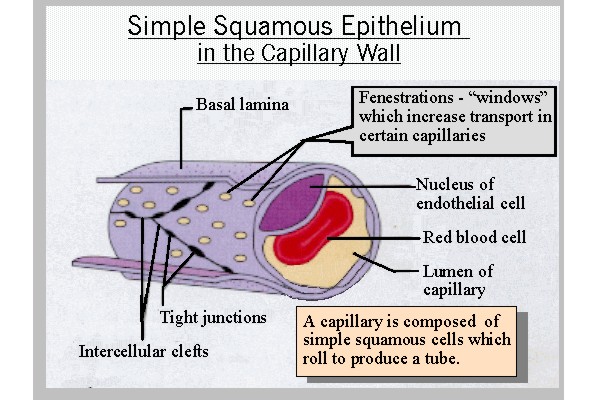Blood vessels are hollow tubes that carry blood through miles and miles of blood vessels in a never ending stream. If you could take all the blood vessels of a average size child and line them up they could reach about 60,000 miles long. In an adult the blood vessels could reach 100,000 miles long.
The blood vessels carry blood between the heart, different tissues, and organs of the body. There are three types of blood vessels: arteries, veins, and capillaries. These blood vessels have the ability to expand to allow more blood to flow through them. They can also contract to help control the flow of blood. The blood flows through the big arteries into smaller ones. The smallest arteries, called arterioles, direct the blood flow into the capillaries. The capillaries connect to the smallest veins called venules. The Veins then return blood to the heart.
Arteries
The arteries are elastic, muscular tubes that carry the blood from the left ventricle of the heart to the capillaries. The walls of the arteries are thicker than the other vessels because of the high pressure. The largest artery is the aorta it is about 1 inch in diameter. The walls of the arteries are 3 layers thick. The inner layer, or tunica intima, consists of single flatten cells called endothelium. The middle layer, or tunica media, is the thicker part of the artery wall. The outer layer, or tunica externa is composed of fibrous connective tissue that give strength to the wall of the artery. The thickness of arteries depends on where it is located within the arterial system. The wall thickness of the arteries prevent the arteries from collapsing. Sometimes there is a weakness in a wall of an artery and this causes the artery to bulge. This abnormal expansion of the artery is called an aneurysm. There is also a problem of the arteries that involves lack of elasticity. This disease comes about because the wall of arteries becoming harden. This abnormal harding is called arteriosclerosis.
Veins
The veins carry blood from capillaries to the heart. The veins increase in size as they progress toward the heart. The veins that connect to the capillaries are venules.They are the smallest of the veins. The veins tend to follow a path parallel with the arteries. However, there are more veins than arteries this is due to the draining of large areas when needed. The veins at any one moment carries about 70 percent of the blood.
The veins are like the arteries in that they have three layers in their walls. However, they are not as thick as arteries. This would also correlate with the lower pressure of blood within them. Located with the veins are valves that allow blood to flow toward the heart but does not allow blood to flow backwards. The veins that are in the lower part of the body tend to have more valves to counteract the force of gravity. The only vein that does not have valves is the vena cava. The valves in the legs sometimes breakdown and allow the blood to flow backwards. This is called varicose veins and is more prevalent in person who stand for long periods of time on hard surfaces.
Capillaries
The capillaries are the smallest working unit in the blood vessels that connect the arterioles to the venules. The walls of the capillaries are only 1 cell thick this allows for the exchange of nutrients and other substances like oxygen and carbon dioxide. Each of the cells in the walls of the capillaries have openings between them so that the exchange can take place. The number of capillaries vary depending on the need for oxygen and other nutrients. The blood flow through the capillaries is regulated by a sphincter, a ring of muscle, that contracts to control the flow of blood through the capillaries. This is important because there would not be enough blood to fill all the blood vessels at one time. This is understandable when one sees that an individual could have between 25,000 to 60,000 miles of capillaries.

